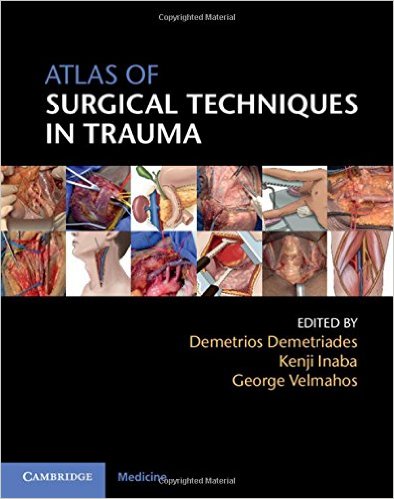Editors: Demetrios Demetriades, MD; Kenji Inaba, MD; and George Velmahos, MD
Publisher: Cambridge University Press – 348 pages, with more than 630 illustrations
Book Review by: Nano Khilnani
This book is, in the words of the editors, “a rapid, highly visual summary of the critical anatomy, procedural sequencing, and pitfalls associated with surgical procedures…it is a review of both common and uncommonly performed procedures prior to proceeding to the operating room.”
It is user-friendly, written for trainees as well as those in practice, including experienced surgeons. It is simply organized around anatomical areas, and its more than 630 high-quality images make this an easy-to-access guide.
Thirty professors and instructors in surgery, including some surgical critical-care fellows, most of them from California, and almost all of them at the Los Angeles County and Southern California Medical Center in Los Angeles, authored the 39 chapters of this book. The contents are organized around these 10 Sections:
- Section 1 – Operating Room General Conduct
- Section 2 – Resuscitative Procedures in the Emergency Room
- Section 3 – Head
- Section 4 – Neck
- Section 5 – Chest
- Section 6 – Abdomen
- Section 7 – Pelvis
- Section 8 – Upper Extremities
- Section 9 – Lower Extremities
- Section 10 – Orthopedic Damage Control
Among the types of information you will find in this book are the following:
- Definitive management of patients
- Exposure levels and their rationale
- General principles of treatment and care
- Step-by-step guide to a given procedure in its entirety
- Technical tips and pitfalls
The images used in this atlas are from fresh, perfused, and ventilated human cadavers. The editors write that “many hundreds of hours” were spent for this project at the University of Southern California Fresh Tissue Dissection Lab.
The editors and authors of this book have extensive real-world clinical experience in managing complex injuries at trauma centers, so you can benefit from their collective knowledge and insight as part of your medical education.
The information and instructions are presented in headings in the chapters in a standard and systematic way, so the reader can more easily understand, remember, and recall the material for the next time a given procedure is to be performed again.
Among the headings you will commonly find in the chapters are the following:
- Surgical anatomy
- General principles
- Special surgical instruments
- Positioning
- Incision
- Procedure
- Technique
- Tips and pitfalls
In some chapters, you will find other detailed instructions to perform certain critical tasks. For example in chapter 4, Emergency Room Resuscitative Thoracotomy, you will find these instructions along with photos, on how to perform the following tasks:
- Open cardiac massage
- Internal cardiac defibrillation
- Pharmacologic treatment of cardiac arrest
- Aortic cross-clamping
- Air embolism
- Hilar occlusion
- Hilar twist
This is a highly valuable, visual, and very practical guide in acute care and trauma surgery. With more than 630 images, step-by-step instructions to numerous surgical procedures, and standardized and systematic presentation of materials in the chapters, it is a welcome guide to learning numerous tasks and acquiring important skills in surgical critical care.
Editors:
Demetrios Demetriades, MD, PhD, FACS is Professor of Surgery at the University of California, and Director of Trauma, Emergency Surgery, and Surgical Critical Care at the Los Angeles County and University of Southern California Medical Center in Los Angeles, California.
Kenji Inaba, MD, MSc, FACS, FRCSC is Associate Professor of Surgery and Emergency Medicine, and Program Director for Surgical Critical Care Fellowship and Surgery Residency at the University of Southern California in Los Angeles, California.
George Velmahos, MD, PhD, FACS is John F. Burke Professor of Surgery at Harvard Medical School, and Chief of Trauma, Emergency Surgery and Surgical Critical Care at Massachusetts General Hospital in Boston, Massachusetts.







